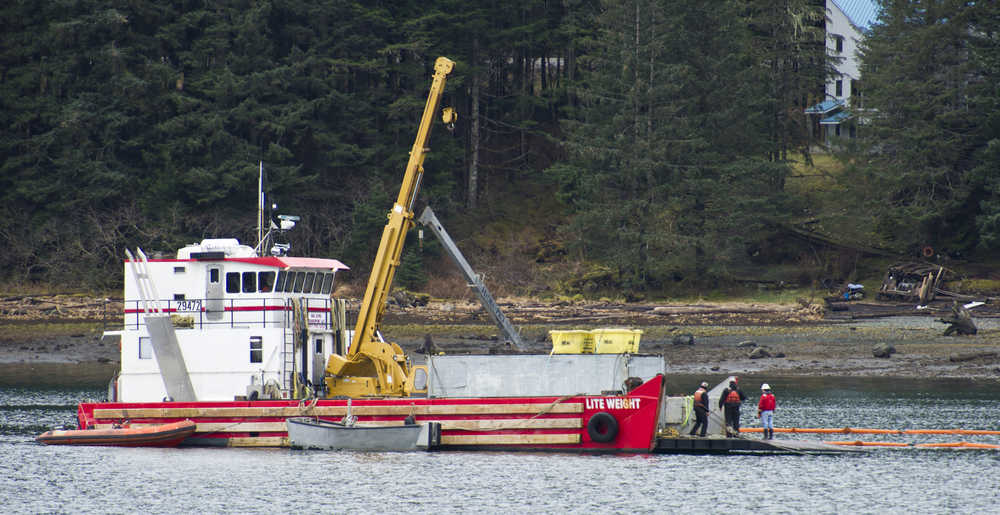The tugboat Challenger, sunken in Gastineau Channel since September, will be lifted from the seafloor within three months, the head of marine pollution response for Coast Guard Sector Juneau said Tuesday.
As divers from Global Diving and Salvage Inc. worked from the dock of the Juneau Yacht Club, Cmdr. Marc Burd said the Coast Guard’s goal is to remove the 96-foot wreck before the start of salmon season.
“This is a significant operation when you have to go and ask permission from the Commandant of the Coast Guard,” he said, explaining the details of the operation.
The Challenger, a tugboat built for the U.S. Army in 1944, sank Sept. 12. Since then, it has been ringed by an orange oil-spill containment boom on the Douglas Island side of the channel near the yacht club.
To raise the Challenger, the Coast Guard has turned to the Oil Spill Liability Trust Fund, which can spend up to $50 million per year to address spills and remove boats, according to Coast Guard documents. When the Challenger sank in September, some oil was removed from the boat, Burd said, but because of its condition, divers weren’t sure they got all of it.
“This is a unique situation where there is an undetermined amount of product still on board, and we need to remove it before it has a large impact,” Burd said.
With the Challenger near the DIPAC fish hatchery and the Mendenhall Wetlands State Game Refuge, two areas designated for protection under the Coast Guard’s spill response plans, it was a prime candidate for the Trust Fund, even if other derelict wrecks in Alaska are not.
Even in an environmentally sensitive area, it took months for a funding request to advance through the Coast Guard bureaucracy: from Sector Juneau to the head of the Coast Guard in Alaska, to the Coast Guard’s Pacific command, then to the commandant.
Five months is a quick turnaround, Burd said, explaining that the process can take a year or more.
With money in hand, the Coast Guard hired Global Diving and Salvage, perhaps the biggest name in Alaska for that line of work.
Kerry Walsh is the manager of the Challenger project for Global and sat in Tuesday’s meeting with Burd. Halfway through, he got a text message from the crew of divers working off the Yacht club dock: The Challenger’s hull appears intact and strong enough to support what will come next.
In the coming week, the divers will run four lift slings through the silt beneath the boat, which is estimated to weigh between 280 and 330 long tons.
Once the slings are secure and in their proper place, a crane will be brought in to do the heavy lifting. The crane will pull the Challenger to the surface, where it will be pumped dry and towed to the Alaska-Juneau Mine dock.
A specialty crew will come in and remove hazardous materials (PCBs, lead paint and asbestos) drain the engines, and remove the batteries. Once that work is done, the Challenger will be towed to a beach, where it will be cut into sections and demolished.
If the resulting debris is free of hazardous materials, it might end up in the Capitol Landfill. If it is contaminated, it might end up barged to a specialized dump in the Lower 48.
The operation promises to be an eye-catching event for Juneauites starting in mid-February, when the crane — scheduled to come from Hoonah — ducks beneath the Juneau-Douglas Bridge. Behind the scenes, there’s already a crowd working from the Federal Building, where Burd said 25-30 Coastguardsmen and women are putting in time, and another eight or so Global employees have joined them.
At the yacht club, the City and Borough of Juneau has loaned the operation its emergency operations center, a converted RV, for staging divers and support personnel.
The work doesn’t come cheap: Burd said about $300,000 has been spent on the Challenger so far, and the project has the authority to spend up to $900,000.
Normally, the owner of the boat is responsible for repaying those costs. In this case, that person — identified as artist R.D. Robinson — has denied he owns the boat.
“As of right now, he’s not claiming to have that responsibility,” Burd said.
This story has been corrected. SouthEast Alaska Lightering was not responsible for removing oil from the Challenger in the weeks after it sank.

